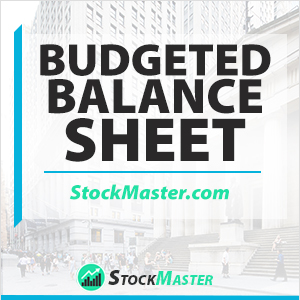 What is the Budgeted Balance Sheet?
What is the Budgeted Balance Sheet?
Definition: A budgeted balance sheet is a financial accounting statement that shows the expected value of assets, liabilities as well as equity over a given period. In other words, the statement tries to show where all accounts in a business or a company will be after a given accounting period.
The accuracy of any budgeted balance sheet depends on the correctness of assumptions that a business makes in the budgeting process.
Budgeted Balance Sheet Components
Companies and businesses prepare financial projections at the beginning of each financial period. Likewise, the process involves budgeting for sales as well as manufacturing costs, expenses, and raw material costs.
Upon making estimates on all the assets, liabilities, and equity expected in a given period, accountants will move forth and start preparing the budgeted balance sheet. The financial statement will consequently provide management insight on how a company’s balance sheet would look like at the end of a given accounting period.
Being an estimate, the values in the budgeted balance sheet are arrived at by making inflation adjustments or by increasing or decreasing capacity. Likewise, adjustment is made at the beginning balances of long term assets, liabilities as well as stockholders equity.
Items Considered in Preparing Budgeted Balance Sheet.
Non-Current Asset
Non-current assets, mostly made up of fixed assets or property, must be adjusted accordingly in the preparation of a budgeted balance sheet. The adjustments are made because fixed assets being crucial to the production process tend to appreciate or depreciate over time. Some of the assets taken into consideration include plants, machinery, equipment, etc.
If a company has any plans to purchase a fixed asset in the future, then it may be included in the current period’s fixed asset and adjusted accordingly based on the policies of a company.
Accounts Receivable
Accounts receivable are also adjusted accordingly in a budget balance sheet. The accounts, in this case, include projected sales and the turnover receivable days. In the preparation of accounts receivable, credit sales are estimated and the turnover ratio indicated detailing the day customers will make payment.
Stockholders’ equity
The equity section comprises of retained earnings as well as common stock/ share. If there are any plans to issue shares as a way of raising capital to finance the business, such financial plans must be included in the master budget and adjusted accordingly in the budgeted balance sheet.
Budgeted Balance Sheet Example
Assume production managers want to construct new manufacturing facilities to enhance production at company XYZ. While enhanced production could trigger an increase in income, there is always a possibility of it triggering an increase in the overall debt load in the balance sheet. It is especially the aces where the company has to take a loan to build more manufacturing facilities.
Likewise, these are some of the things that managers must think about when going through a budgeted balance sheet.
Budgeted Balance Sheet Use & Importance
A budgeted balance sheet being an estimate could help uncover unfavorable financial conditions that need immediate management action. For instance, if a business intends to raise a massive chunk of debt to finance operations, management must be ready to ensure the debt to equity ratio does not shoot up.
A budgeted balance sheet also serves as a financial check on the mathematical accuracy of other schedules that a business or a company intends to undertake. Likewise, it helps management carry out a variety of ratio calculations based on the estimation carried out. The statement can also help highlight future resources and their potential use.
Summary
A budgeted balance sheet allows management to carry out a reality check of a business as well as initiate corrective action where necessary. A review of the budgeted balance sheet could provide insights into how a company is likely to perform. Likewise, the statement provides a complete picture of the company’s assets, liabilities as well as shareholders’ equity.
